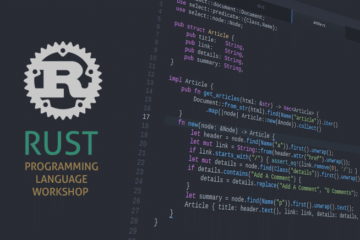Introduction
When it comes to modern programming languages, Go and Rust are often hailed as two of the most promising contenders. Both have gained significant traction in recent years, each with its own set of strengths and weaknesses. In this article, we’ll delve into a comprehensive comparison between Go and Rust, examining various aspects such as performance, concurrency, safety, ease of use, and ecosystem support.
Background
Go, also known as Golang, was developed by Google in 2007 and released to the public in 2009. It was designed to address the challenges of building scalable and efficient software systems. Rust, on the other hand, originated from Mozilla Research and was introduced to the public in 2010. Rust focuses heavily on safety, concurrency, and performance.
Performance
Performance is a critical factor for many developers, especially those working on systems software and performance-critical applications. Both Go and Rust offer impressive performance characteristics, but they achieve this in different ways.
- Go: Go prioritizes simplicity and ease of use while still delivering competitive performance. Its runtime, built-in garbage collector, and concurrency primitives make it well-suited for building highly concurrent systems. However, Go’s garbage collector can occasionally lead to unpredictable latency spikes, particularly in applications sensitive to latency.
- Rust: Rust’s performance is often considered superior to Go, thanks to its emphasis on zero-cost abstractions and fine-grained control over memory management. Rust’s ownership system and borrow checker enable memory safety without the need for garbage collection, resulting in predictable performance and low-level control over system resources.
Example:
// Rust
fn main() {
let mut sum = 0;
for i in 0..1_000_000 {
sum += i;
}
println!("Sum: {}", sum);
}
// Go
package main
import "fmt"
func main() {
sum := 0
for i := 0; i < 1000000; i++ {
sum += i
}
fmt.Println("Sum:", sum)
}
Concurrency
Both Go and Rust provide robust concurrency support, which is essential for building scalable and efficient software systems.
- Go: Go’s concurrency model is based on goroutines and channels, making it easy to write concurrent programs. Goroutines are lightweight threads managed by the Go runtime, and channels facilitate communication and synchronization between goroutines. This model simplifies concurrent programming compared to traditional threading approaches.
- Rust: Rust’s concurrency model is based on the ownership system and the concept of
SendandSynctraits. Rust ensures memory safety and thread safety through its ownership and borrowing rules, preventing data races and other common concurrency bugs at compile time. While Rust’s concurrency model can be more challenging to grasp initially, it offers a high level of safety and performance.
Example:
// Rust
use std::thread;
use std::sync::mpsc;
fn main() {
let (sender, receiver) = mpsc::channel();
let handle = thread::spawn(move || {
sender.send("Hello from Rust").unwrap();
});
let message = receiver.recv().unwrap();
println!("{}", message);
handle.join().unwrap();
}
// Go
package main
import (
"fmt"
)
func main() {
messages := make(chan string)
go func() {
messages <- "Hello from Go"
}()
message := <-messages
fmt.Println(message)
}
Safety
Safety is a paramount concern for developers, especially when building systems that handle sensitive data or have strict reliability requirements.
- Go: Go prioritizes simplicity and readability, which contributes to its safety to some extent. However, Go lacks features such as memory safety guarantees provided by Rust’s ownership system. While Go’s runtime and standard library include mechanisms to mitigate common issues like null pointer dereferences, developers must still be vigilant to avoid certain types of bugs.
- Rust: Rust is renowned for its focus on safety and correctness. Its ownership system, borrow checker, and type system work together to prevent common programming errors such as null pointer dereferences, data races, and memory leaks. Rust’s compiler enforces these safety guarantees at compile time, making it virtually impossible to write unsafe code without explicitly opting out of safety checks.
Example:
// Rust
fn main() {
let mut data = vec![1, 2, 3];
let first = &data[0]; // Immutable borrow
data.push(4); // Error: cannot borrow `data` as mutable because it is also borrowed as immutable
println!("First element: {}", first);
}
// Go
package main
import "fmt"
func main() {
data := []int{1, 2, 3}
first := &data[0] // Immutable borrow
data = append(data, 4) // No error in Go
fmt.Println("First element:", *first)
}
Ecosystem Support
The ecosystem surrounding a programming language plays a significant role in its adoption and long-term viability. Both Go and Rust have vibrant ecosystems with extensive libraries, frameworks, and tooling support.
- Go: Go benefits from the backing of major tech companies like Google, which ensures robust support and continued development. It has a rich standard library and a growing ecosystem of third-party packages available through the official package manager,
go get. Go’s simplicity and ease of deployment have contributed to its popularity for building web servers, microservices, and command-line tools. - Rust: Rust’s ecosystem has been rapidly expanding, driven by an enthusiastic community and strong corporate support from companies like Mozilla and Microsoft. It boasts a powerful package manager called Cargo, which simplifies dependency management and project setup. Rust is gaining traction in various domains, including systems programming, web development, and embedded systems.
Conclusion
In conclusion, both Go and Rust offer compelling features and are well-suited for different use cases. Go excels in simplicity, concurrency, and ease of deployment, making it an excellent choice for building scalable web services and command-line tools. Rust, on the other hand, prioritizes safety, performance, and low-level control, making it ideal for systems programming, performance-critical applications, and projects where safety and reliability are paramount. Ultimately, the choice between Go and Rust depends on the specific requirements of the project and the preferences of the development team.



1 Comment
Paul Duncanson · April 25, 2024 at 8:44 am
Thank you Jason for the review and your contrast presented here regarding Rust’s equivalent approach to GoLang’s Message Driven cross thread communication strategy (i.e. channel architecture). Will take a closer look at what Rust can do.